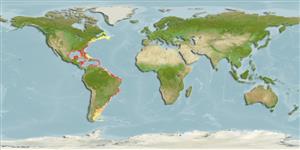Common names from other countries
Environment: milieu / climate zone / depth range / distribution range
Ecologia
; intervalo de profundidade 10 - 76 m (Ref. 1821). Tropical
Western Atlantic: USA, Canada, Bermuda to Brazil.
Length at first maturity / Tamanho / Peso / Idade
Maturity: Lm ? range ? - ? cm Max length : 1.1 cm SHL macho/indeterminado; (Ref. 3441)
Shell medium size, white, slightly curved. Six primary ribs extending over entire shell to oral aperture. Striated between ribs. Apical, oral sections hexagonal.
Empty shells were recorded at depths of 47 to 260 m (Ref. 3441).
Life cycle and mating behavior
Maturidade | Reprodução | Desova | Ovos | Fecundidade | Larvas
Members of the class Scaphopoda are gonochoric. Fertilization occurs in the mantle cavity. Life cycle: Eggs hatch into free-swimming lecithotrophic trochophore larvae, succeeded by shelled veligers.
Steiner, G. and A.R. Kabat. 2004. (Ref. 1821)
Categoria na Lista Vermelha da IUCN (Ref. 130435)
Categoria CITES (Ref. 108899)
Not Evaluated
Not Evaluated
Utilização humana
| FishSource |
Ferramentas
Mais informação
Idade/TamanhoCrescimentoComprimento-pesoComprimento-comprimentoMorfologiaLarvasAbundância
Fontes da internet
Estimates based on models
Preferred temperature
(Ref.
115969): 7.5 - 27.6, mean 23.5 (based on 542 cells).
Vulnerabilidade
Low vulnerability (10 of 100).
Categoria de preço
Unknown.
